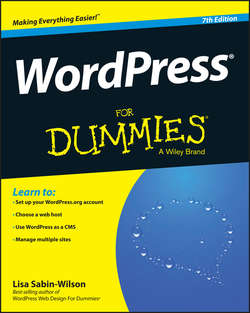Читать книгу WordPress For Dummies - Sabin-Wilson Lisa - Страница 11
Part I
Introducing WordPress
Chapter 2
WordPress Basics
Using WordPress as a Content Management System
ОглавлениеYou hear something like the following a lot if you browse different websites that publish articles about WordPress: “WordPress is more than a blogging platform; it’s a full content management system.” A content management system (CMS) is a platform that gives you the capability to run a full website on your domain. This means that in addition to hosting a blog, you can build pages and have additional features built into your website that have nothing to do with the content on your blog.
Exploring the difference between a website and a blog
A website and a blog are really two different things. Although a website can contain a blog, a blog doesn’t and can’t contain a full website. I know it sounds confusing, but after you read this section and explore the difference between the two, you’ll have a better understanding.
A blog is a chronological display of content, most often posts or articles written by the blog author. Those posts (or articles) are published and, usually, categorized into topics and archived by date. Blog posts can have comments activated, which means that readers of a blog post can leave their feedback and the blog post author can respond, thereby creating an ongoing dialog between author and reader about the blog post.
A website is a collection of published pages and sections that offer the visitor a variety of experiences or information. Part of the website can be a blog that enhances the overall visitor experience, but it usually includes other sections and features that might include things such as the following:
✔ Photo galleries: This specific area of your website houses albums and galleries of uploaded photos, allowing your visitors to browse through and comment on the photos you display.
✔ E-commerce store: This feature is a fully integrated shopping cart through which you can upload products for sale, and your visitors can purchase your products via your online store.
✔ Discussion forums: This area of your website allows visitors to join, create discussion threads, and respond back and forth to one another in specific threads of conversation.
✔ Social community: This section of your website allows visitors to become members, create profiles, become friends with other members, create groups, and aggregate community activity.
✔ Portfolio of work: If you’re a photographer or web designer, for example, you can display your work in a specific section of your site.
✔ Feedback forms: You can have a page on your website with a contact form that visitors can fill out to contact you via email.
✔ Static pages such as a Bio, FAQ (Frequently Asked Questions), or Services page: These pages don’t change as often as a blog page does. Blog pages change each time you publish a new post. Static pages contain content that doesn’t change very often.
Viewing examples: Blog versus website
I include a couple of figures in this section to further illustrate the difference between a blog and a website. Figure 2-4 shows the front page of my personal blog located at http://lisasabin-wilson.com. Notice that the site displays a chronological listing of the most recent blog posts I’ve made. On my personal site, I use WordPress primarily as a blogging tool.
Figure 2-4: My personal blog uses WordPress as a blogging tool.
In contrast, my business website, located at http://webdevstudios.com, uses WordPress as a CMS to publish a full website. This site includes a static front page of information that acts as a portal into the rest of the site, where you find a blog, a portfolio of work, a contact form, an order form, and various static pages used to tell my visitors more about the business. The static pages include services, FAQ, Terms of Service, Privacy Policy, and more.
Check out Figure 2-5 for a look at the front page of my business site at WebDevStudios and notice how it’s quite different from my personal blog site, shown in Figure 2-4.
Figure 2-5: My business website uses WordPress as a CMS.
Using WordPress as a CMS means that you’re using it to create not just a blog but an entire website full of sections and features that offer a different experience for your visitors.
